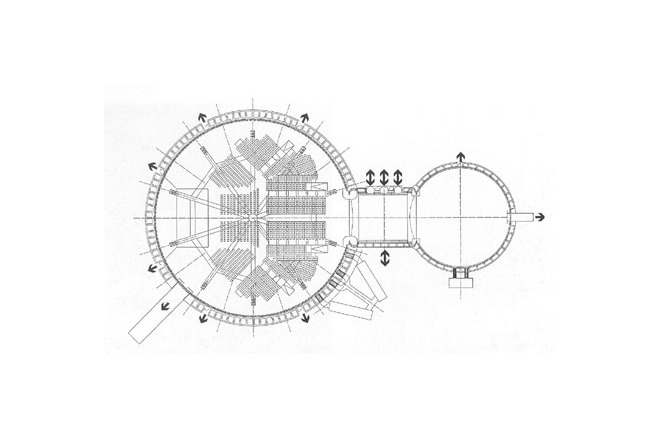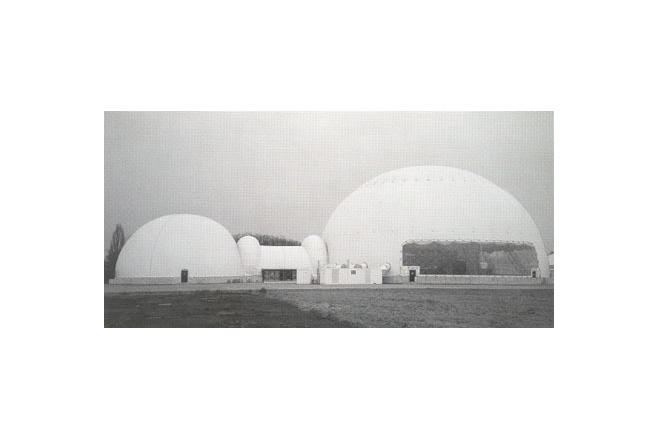Mediadrome Mobile Air Hall for 'ZDF' TV (Germany)
General information
-
Location address
Munich
-
Location country
Germany
-
Year of construction
1995
-
Name of the client/building owner
Mediadrom GmbH together with ZDF
-
Function of building
Entertainment & recreation
-
Degree of enclosure
Fully enclosed structure
-
Climatic zone
Temperate - cold winters and mild summers
Description
Design
The origins of this project go back some way. The second German television channel, ZDF, and Mediadrom GmbH were first interested in the concept of a provisional, but then still stationary pavilion for erection at the Munich trade fair site. During the scheme design phase the pavilion was conceived as a pneumatic structure, i.e. as air-supported. As the ZDF ultimately wanted to also set up the hall in the centres of other large cities, for example next to the Brandenburg Gate in Berlin and beside Cologne Cathedral, and to use it for spectacular music events, three essential requirements were added:
- The hall had to be mobile, i.e. easy to erect and to dismantle.
- It had to be transparent from the outside, so that people could look in. - It should have good acoustic qualities.
- Lighting and acoustical equipment of approx. 30 t had to be housed in the hall.
Concept
In co-operation between the architects and the membrane engineers the following solution emerged.
To enable the air hall to be moved quickly from one place to the next, the stationary solid concrete foundations were replaced by mobile, water-filled concrete troughs. All parts had to be designed to be transportable and storable, and very precise schedules were required to be able to erect and dismantle the hall within a week. The entire hall has a transport volume of 60 pick-up trucks.
The requirement to show from outside what's happening inside, was partly fulfilled by the translucency of the chosen material (PVC/PES). During performances at night the spotlights project reflections and shadows onto the hall membrane. As a further measure the sides of the larger hall were opened in the bottom part by the installation of three large transparent foil windows (6 m x 30 m) which permit visual communication between inside and outside. Tele- casts therefore are not only watched by the guests present in the Mediadrome but also by many spectators who gather in front of the large foil windows.
Naturally the ZDF gave high priority to acoustics; by means of suspended acoustic sails and acrylic glass reflectors the required high-grade acoustics with concert quality could be achieved. Since it was not possible to attach 30 t of lighting and sound equipment to the pneumatic hall skin due to the resulting high point loads, it was decided, especially with regard to the accommodation of airconditioning and ventilation ducts, to install a separate technology table in steel construction.
Plan
The plan form of the large hall (with a floor space of 1950 m²) is circular, at Ø 51 m, which is joined through a short, cylindrical centrepiece (floor space 190 rn2) with the small hall (floor space 500 m² ) at Ø 26 m. Over it the roof arches in the form of two hemispheres joined by a cylindrical membrane.
The main entrances are situated in two containers at the cylindrical centrepiece, with three revolving doors on one side and one revolving and six escape doors on the other side. The large hall has to have seven emergency exits, according to the building regulations, whereby it has a maximum capacity for approx. 3000 people. In addition a forklift and a truck airlock were installed, the latter with a length of 19 m.
The covered plan area is 2700 m²; 1800 seats can be installed at the Mediadrome; without seating it has a maximum capacity of 3000 people.
Description of the environmental conditions
Structure
The structure is an air hall according to DIN 4134 and was designed with respect to the guideIines for movable buildings. The membrane domes are prestressed through the inside air pres- sure and transfer their loads into the gravity foundations. A blower provides an air pressure of 30-50 mm water gauge; which is controlled by the wind speed and increased automatically if required.
At the transition to the cylindrical centrepiece a membrane collar is installed on each side, which accommodates the displacements and movements of the two different membrane structures meeting. To allow a movement of the hall under load relative to the rigid structures of truck and forklift air lock they were also connected with a collar. The frames of the emergency exits, however are connected to the main membrane without collar and therefore had to be designed to resist the applied membrane forces.
Roof membrane
For the large hall a PVC-coated polyester fabric type IV was used while for the small hall a type 11 proved sufficient. The membrane windows are made from ET foil (with 200 pm thickness), to stiffen the high membrane force of the large hall, it was reinforced by a cable net with a mesh width of 1.0 m x 1.0 m.
Since various unusual building materials were used, i.e. - PVC-coated PES fabrics type II and type IV, as well as - ET foil for the windows, a proof of the suitability of these materials was required according to the German building code through a process of consent for the individual case, i.e. the suitability of the materials had to be demonstrated with regard to their structural and fire-resistant material characteristics.
The roof membrane is connected to the p.c. foundations via short tube pieces inserted in a welded membrane pocket; the tube clamps made from steel flat are bolted onto a Halfen rail cast into the concrete. A lateral displacement of the tubes is prevented through a welded-on tube flange. The space is sealed through an inner membrane apron, welded onto the main membrane and lying loose in the lower part the building. Any air losses occurring are replenished by the blowers.
Transparent membrane window
For clear transparent membranes only a limited number of foils are available and these generally only have a limited tensile strength. In addition a material classified as difficult to ignite was required. The material chosen was a combination of a difficult-to-ignite ET foil reinforced by an outer steel cable net with a mesh width of 1 x 1 m. The main disadvantage of the foil material is that it would be destroyed after approx. 2 to 3 erections through creasing, unless additional protective measures were taken. To avoid this wear and tear, the hall is equipped for installation with an opaque window of PVC-coated polyester fabric, which after inflation is replaced under inside pressure by the cable net and the ET foil.
The foil structure between the meshes of the steel cable net transfers the inside air pressure through tension forces in the membrane. The steel cable sheds its load via corner plates into the garland edge of the main membrane and is thus part of the dome membrane. The garland edge is composed of an endless edge cable, running in a membrane pocket. At the connection points of the net, cables corner plates are installed outside and inside of the membrane joined together by bolts; the net cables are pin connected via a separate connection plate.
The foil and the opaque window membrane from PVC-coated polyester fabric are connected with the main membrane by a staggered clamping strip connection with boltrope.
General comments, links
Foundations
The mobile foundations (1.35 m x 2.20 m, h = 1.20 m) are trough-shaped precast concrete elements, which are filled with water. By this measure the transport weight could be reduced by 1/3 from originally 900 t, as a compromise between the conflicting requirements of a low trans- port weight on the one hand and high ballast weight and small volume in the installed condition on the other .The forces are carried almost vertically into the foundations so that the available weight is optimally utilised.
Installations
Acoustics: Wall and ceiling sails and acoustical reflectors
To achieve the required, high-grade interior acoustics with the unfavourable hemispherical form, 40 triangular point-connected roof and wall sails were installed and suspended from the roof membrane.
The acoustics sails are composed of a PVC-PES-net fabric, covered with a 6-cm thick mineral wool blanket. Because of the net the sound is not reflected at the inner surface, but penetrates the acoustics package, becomes reflected at the second, outer surface of the insulation package, runs a second time through the insulation layer and is so optimally (i.e. doubly) dampened. The wall sails work the same way.
Through the installation of hard acrylic glass panels at the technology table the sound arriving in the lower areas is unevenly reflected and thus modifies the reverberation time.
Air-conditioning
The space is ventilated with 90 000 m³/h and is fully air conditioned, the required air-conditioning plant is housed in two containers set up beside the halls.
Floor
The floor is an adjustable floor system with Mobilplex floor slabs and a permissible live load of 10 kN/m².
Assembly
The erection and dismantling takes only a week due to a specially trained, 50-strong installation crew. Delivery and placing of the foundations takes place according to a precise schedule. The foundation elements are assembled directly from the truck, other components are unloaded and distributed with forklifts. The spreading of the membrane can only be done by hand, i.e. through employment of as many workers as possible. As a protective measure slip foils are used, for example when pulling the membrane over the foundations.
When inflating the hall while it rains there is always the danger of pooling, which must be pumped out if necessary; under strong wind conditions the hall cannot be inflated.
The foil window is installed as follows: he hall is inflated with the help of the opaque window of PVC-coated polyester fabric; then the inside air pressure is lowered for the installation of ET-foil and cable net. The ET-foil is placed in position and clamped on; then the stainless steel cable net is assembled and fixed from the outside. The opaque window membrane is disconnected at the bottom and at the side, rolled up to the top and remains hanging there as a curtain (and is available as such if required).The inside pressure is raised a4ain to the standard level. Installation of the foil window extends the total setting-up time, but as the ET foil was the only material available which was classified as difficult to ignite, this disadvantage was inevitable.
[Soft Shells, Hans-Joachim Schock, p114-116, 118]
Mediadrome Mobile Air Hall for 'ZDF' TV, Germany
Material of the cover
-
Cable-net/Fabric/Hybrid/Foil
Foil
-
Material Fabric/Foil
Polyester
-
Material coating
PVC
Main dimensions and form
-
Covered surface (m2)
1950
-
Total length (m)
51
-
Total width (m)
51
Duration of use
-
Temporary or permanent structure
Permanent
-
Convertible or mobile
Convertible and mobile
-
Design lifespan in years
00-05
Involved companies
-
Architects
IF Ingenieurgemeinschaft Flächentragwerke
-
Engineers
IF Ingenieurgemeinschaft Flächentragwerke
Editor
-
Editor
Marijke M. Mollaert





